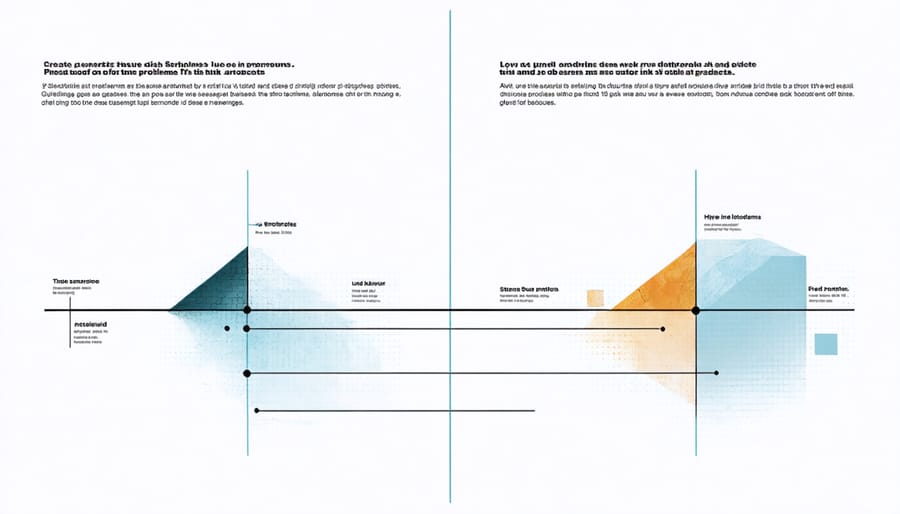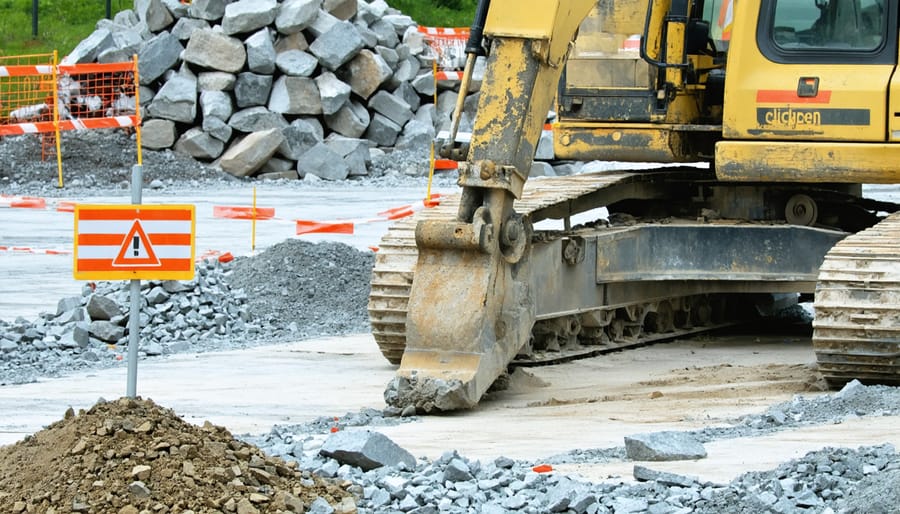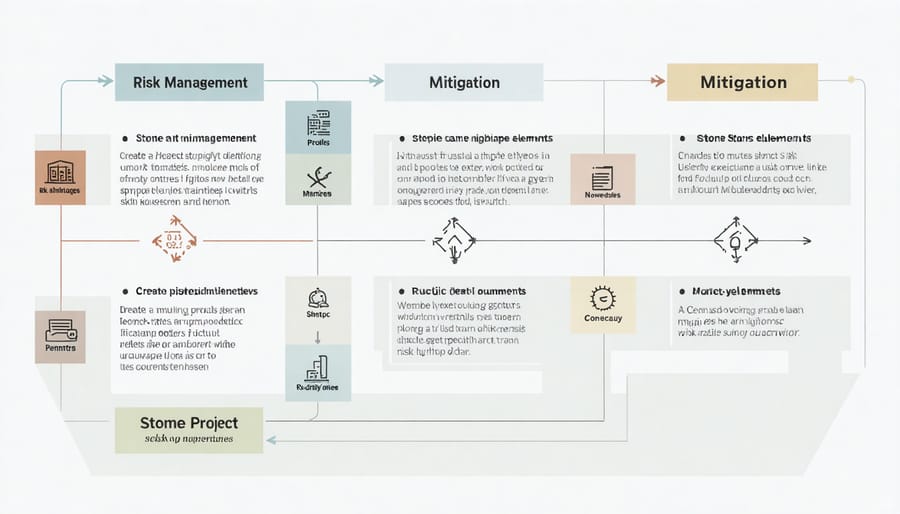In the high-stakes world of project management, the difference between risks and issues can make or break a project’s success. While risks represent potential future events that could impact project outcomes, issues are active problems demanding immediate attention. Understanding this critical distinction enables project managers to implement effective strategies, allocate resources efficiently, and maintain control over project deliverables.
Consider a natural stone installation project: A risk might be potential material delivery delays due to quarry operations, while an issue is discovering structural defects in the existing foundation during installation. This fundamental difference shapes how project managers approach challenges – risk management focuses on prevention and mitigation strategies, while issue management demands direct problem-solving and immediate action.
Modern project management requires mastery of both risk anticipation and issue resolution. Industry leaders recognize that successful project delivery hinges on the ability to transform potential risks into manageable contingencies while addressing current issues with decisive action. This dynamic approach ensures projects stay on track, maintain budget constraints, and meet quality expectations, particularly crucial in complex stone installation projects where material costs and timeline precision are paramount.
Understanding Risks in Stone Project Management
Common Stone Project Risks
Natural stone projects face distinct risks that require careful consideration during the planning phase. Material availability poses a significant challenge, as specific stone types may become scarce or discontinued, potentially impacting project timelines and budgets. Weather conditions can severely affect installation schedules and stone integrity, particularly during outdoor applications where temperature fluctuations and moisture exposure are concerns.
Structural considerations represent another critical risk category. Load-bearing capacities, foundation stability, and proper support systems must be thoroughly evaluated to prevent future complications. Following sustainable stone project practices can help mitigate some of these risks while ensuring long-term project success.
Quality variations in natural stone batches can lead to aesthetic inconsistencies, potentially requiring additional material orders or design modifications. Transportation and handling risks are also significant, as stone materials are susceptible to damage during transit and installation. Labor availability and expertise present ongoing challenges, as skilled craftsmen are essential for proper stone installation and finishing.
To effectively manage these risks, project managers should maintain detailed contingency plans and establish strong relationships with reliable suppliers and contractors.
Risk Assessment and Identification
Effective risk assessment in stone projects begins with systematic identification and evaluation of potential challenges before they materialize into issues. Using modern project planning tools, teams can conduct thorough risk analyses through various methods including brainstorming sessions, expert interviews, and historical data review.
Key assessment techniques include:
– Probability and impact matrix evaluation
– SWOT analysis focused on stone-specific challenges
– Regular stakeholder consultations
– Site condition assessments
– Supply chain vulnerability analysis
For natural stone projects, particular attention should be paid to material-specific risks such as quarry availability, color variations, and structural integrity concerns. Environmental factors, including weather conditions and site accessibility, must also be carefully evaluated.
Documentation is crucial during this phase. Create detailed risk registers that capture potential threats, their likelihood, potential impact, and proposed mitigation strategies. Regular review and updates of these assessments ensure that emerging risks are identified early and can be addressed before becoming active issues requiring immediate attention.

When Risks Become Issues
Real-World Examples
Consider a high-end residential project where a contractor identified potential marble slab veining inconsistency as a risk during the planning phase. When the material arrived, significant variation in the veining patterns became an actual issue, requiring immediate resolution through additional slab selection and increased costs.
Another illustrative example occurred during a commercial lobby installation where the risk of delayed material delivery was noted early on. When the quarry experienced unexpected equipment failure, this risk transformed into an issue, pushing the project timeline back by six weeks and necessitating temporary flooring solutions.
In a hotel renovation project, the team identified potential moisture problems in the substrate as a risk for natural stone installation. This risk later manifested as an issue when humidity levels exceeded acceptable thresholds, requiring additional waterproofing measures and delaying the installation process by two weeks.
A courthouse restoration project demonstrates how unidentified risks can become critical issues. While weather-related delays were anticipated, an unmarked utility line discovered during foundation work for new stone columns became an unexpected issue, requiring emergency replanning and additional permits.
Each of these cases highlights the importance of thorough risk assessment and having contingency plans in place. The projects that recovered most effectively were those that had already developed response strategies during their risk assessment phase, allowing for quicker issue resolution and minimal impact on project outcomes.
Prevention Strategies
Effective prevention of risks from becoming issues requires a proactive and systematic approach. Start by implementing a robust risk identification process during the project planning phase. This should include thorough site assessments, material quality checks, and detailed documentation of potential complications specific to each stone installation project.
Establish a comprehensive risk register that categorizes potential risks based on their likelihood and impact. Regular team meetings should be scheduled to review and update this register, ensuring all stakeholders remain informed and aligned. Implementation of early warning systems can help detect signs of developing issues before they materialize.
Risk mitigation planning should include clear response strategies for each identified risk. For instance, when working with natural stone, having backup suppliers pre-qualified can prevent delays if material availability becomes an issue. Similarly, maintaining a buffer in the project timeline accounts for potential weather-related delays that could affect installation schedules.
Regular quality control checks throughout the project lifecycle help identify potential problems early. This includes monitoring material storage conditions, checking installation techniques, and verifying proper sealing procedures. Training team members to recognize risk indicators and establishing clear communication channels for reporting concerns are essential prevention measures.
Consider implementing a change management system to control scope modifications that could introduce new risks. Document all decisions and maintain detailed records of risk prevention activities to build a knowledge base for future projects.

Proactive Risk Management Techniques

Risk Mitigation Planning
Effective risk mitigation planning is crucial for successful stone projects, requiring a systematic approach that anticipates and addresses potential challenges before they materialize. Following best practices for stone projects starts with thorough documentation of identified risks and development of specific response strategies.
Begin by categorizing risks based on their probability and potential impact. For stone projects, common categories include material defects, installation complications, weather-related delays, and supply chain disruptions. Create detailed contingency plans for each high-priority risk, including specific action steps, responsible parties, and required resources.
Establish clear triggers that indicate when mitigation actions should be implemented. For example, if moisture levels exceed specified thresholds during installation, have predetermined procedures ready to protect the stone and adjust the timeline accordingly. Maintain a risk register that tracks:
– Risk description and category
– Probability and impact ratings
– Mitigation strategies and triggers
– Resource requirements
– Timeline implications
– Cost considerations
– Response team assignments
Review and update mitigation plans regularly throughout the project lifecycle, particularly when scope changes occur or new risks emerge. Ensure all stakeholders understand their roles in risk response and have access to necessary resources and information.
Remember to document successful mitigation strategies and lessons learned for future reference. This creates a valuable knowledge base that improves risk management capabilities across subsequent stone projects and strengthens overall project outcomes.
Monitoring and Control
Effective monitoring and control of project risks requires a systematic approach throughout the project lifecycle. Daily site inspections and regular team meetings help identify emerging risks before they become issues, particularly in stone installation projects where material quality and installation techniques are crucial.
Project managers should maintain a risk register that tracks identified risks, their probability, potential impact, and current status. This living document should be updated weekly, recording any changes in risk severity or new mitigation strategies implemented. For stone projects, this might include monitoring moisture levels, structural integrity assessments, and quality control checkpoints.
Key performance indicators (KPIs) should be established to measure risk management effectiveness. These might include the number of successfully mitigated risks, response time to emerging issues, and the ratio of identified risks that become actual problems. Regular reporting through dashboard visualizations helps stakeholders quickly understand the project’s risk profile.
Control measures should be implemented at critical project phases. For stone installations, these typically include material delivery inspection, substrate preparation verification, and installation technique validation. Each control point should have clear acceptance criteria and documented procedures for addressing deviations.
A feedback loop system ensures lessons learned are captured and applied to future risk assessments. This might involve post-installation reviews, contractor performance evaluations, and documentation of successful risk mitigation strategies. Regular team training sessions help maintain awareness of risk management protocols and improve response capabilities.
Effective risk monitoring also requires clear communication channels between all stakeholders. This includes regular updates to clients, contractors, and suppliers about potential risks and mitigation efforts, ensuring everyone remains aligned with project risk management objectives.
Tools and Best Practices
Effective risk and issue management in stone projects requires a combination of proven tools and methodologies. Project managers should utilize both traditional and digital risk management tools to maintain comprehensive oversight throughout the project lifecycle.
Risk registers serve as fundamental tools for tracking potential threats and opportunities. These documents should include detailed descriptions of risks, their probability and impact ratings, proposed mitigation strategies, and designated team members responsible for monitoring each risk. For stone projects specifically, risk registers should incorporate material-specific considerations such as quarry availability, transportation logistics, and installation complexities.
Project management software with integrated risk management features has become increasingly essential. These platforms enable real-time monitoring of risk indicators, automated alert systems, and collaborative risk response planning. Many solutions offer specialized modules for natural stone projects, including material tracking and quality control checkpoints.
Industry best practices emphasize regular risk review meetings, typically conducted bi-weekly or monthly depending on project scope. These sessions should involve key stakeholders, including stone suppliers, installers, and project managers, to ensure comprehensive risk assessment from multiple perspectives.
Documentation protocols are crucial for both risk and issue management. Standardized templates for risk assessment, issue logs, and incident reports help maintain consistency and facilitate clear communication across project teams. These documents should be readily accessible through a centralized project management system.
Visual management tools, such as risk heat maps and status dashboards, provide quick insights into project health. Color-coding systems help prioritize risks and issues, while progress tracking charts monitor the effectiveness of implemented solutions.
For stone-specific projects, material testing protocols and quality assurance checklists serve as preventive tools against common issues. These should be integrated into the broader risk management framework, with clear escalation procedures when quality concerns arise.
Effective risk and issue management is crucial for the success of any stone project. By understanding the fundamental differences between risks and potential issues, project managers can better prepare for and respond to challenges that arise during stone installation and fabrication. Regular risk assessments, proactive monitoring, and clear communication channels help teams identify potential problems early and implement mitigation strategies before they impact project timelines or budgets. Remember that while risks can often be anticipated and managed, issues require immediate attention and resolution. Maintaining detailed documentation of both risks and issues creates valuable learning opportunities for future projects and helps establish best practices within your organization. Success in stone project management ultimately depends on balancing thorough risk management with efficient issue resolution while maintaining focus on project objectives and quality standards.










